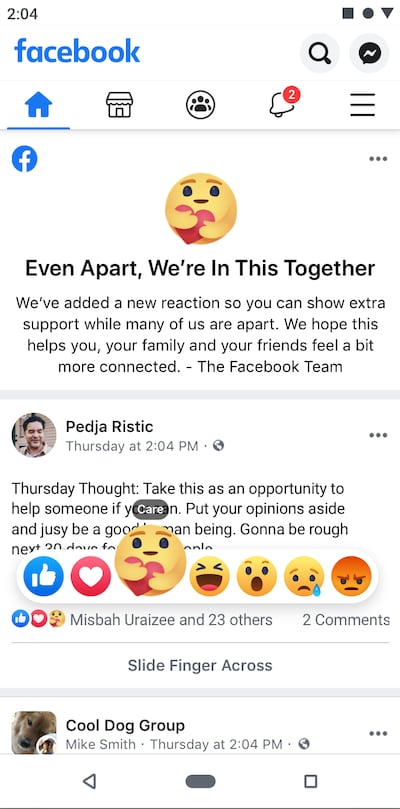Strip social media back to its bare bones and you find that it has two purposes.
The first is to help us communicate. Thanks to Facebook, Instagram, Twitter, LinkedIn and others, we’ve never been so connected. We sign up to stay in touch with friends, find like-minded people and feel part of a thriving digital society.
The second, sitting under the radar, is to find out how we’re feeling. The ability of social media platforms to guess our attitudes towards a given stimulus is what gives them power and value. Over time, they get better at presenting us with things we find interesting, satisfying and alluring.
Then, once they’ve got our attention, they sell that attention to advertisers. The more detailed the picture of our likes and dislikes, the more money that can be made.

Getting us to express how we feel about things isn't always easy, though –we're busy creatures. But, five years ago, Facebook launched Reactions, a series of emoji positioned under every piece of content which let us give an emotional response without having to type anything. Alongside the thumbs-up "Like", there were five new options to choose from: Love, Haha, Wow, Sad or Angry.
Now, after years of blowing hot and cold on the idea, Twitter is surveying its community on how it might feel about a similar set being introduced to the platform. “We’re exploring additional ways for people to express themselves,” said a spokesperson. The unannounced subtext: they’d like to get to know more about us.
Users of social media don’t like change, and Twitter's are more pernickety than most. When the platform changed its star button (effectively a bookmark) to a heart button in late 2015, the irritation was palpable; many resented what they saw as unnecessary infantilisation, a process of dumbing down. But, eventually, they got used to it.
The same happened when Facebook Reactions launched a few months later. They received a distinctly lukewarm reception, as people shunned them in favour of the “Like” button they were more familiar with. But, over the summer of 2016, usage picked up. By 2018, clicks on the six Reactions constituted 12.8 per cent of all interactions on Facebook.
“It's now not uncommon to see posts with much higher numbers of 'hearts' or 'wow' or 'angry' emoji than regular likes,” says British digital marketing consultant Dan Barker. People soon realised the value of being able to specify annoyance, adoration or amazement.
This, of course, also brought value to Facebook, because the marketing industry doesn’t place great importance on a “like”. It doesn’t reveal as much about someone if they’d made the effort to share a post or leave a comment. Reactions, however, can build a more detailed profile of users who are hardest to reach: the ones who can’t be bothered to share or comment, but are happy to click a button. They can also help to categorise and promote posts.
“Platforms are able to show people much more of the types of content that generate 'awesome' or 'angry' responses than just vanilla content,” says Barker. “And that’s interesting from a human point of view: designing algorithms to trigger particular emotional responses, and to do so at a much greater frequency than humans would normally deal with.
“They also allow the measurement of things that could explicitly be used for ad sales. For example: 'Your promoted trend was interacted with 10,000,000 times, with a high support rating, low anger rating, moderate awesome rating’, rather than just reporting on the number of views.”
Facebook put in the work in establishing Reactions as a social media norm, risking the ire of its community, but it paid off – and over the past 18 months, many other platforms have followed suit.
In 2019, LinkedIn responded to users who apparently demanded “more ways to feel heard” by introducing a series of new reactions: Celebrate, Love, Insightful and Curious. (Shortly afterwards, they added “Support”, too.) A company blog post explained that this would help “the poster understand the impact their post had on the person who reacted". Crucially, it would help LinkedIn understand the same thing.
In January 2020, Twitter introduced reactions (LOL, Shocked, Crying, Heart and Fire) to its direct message section. Google Duo did, too. Last summer, they began to crop up on messaging apps. As Covid-19 swept the world, Facebook added a Hug to its reactions. And now, as Twitter considers bringing them to its public platform, Instagram is testing an expansion of reactions on its Stories platform, widening the scope of emotions that can be expressed with a press of the thumb. It is expected to launch imminently.
With reactions now an established part of the online lexicon, the response to Twitter’s survey has been more of a shrug of acceptance than a howl of anguish. Yes, there are dissenting voices (“Emojis everywhere ... as Twitter's magic is simplicity I hope this won't come,” tweeted one user), but there’s a growing recognition that they have their place. “I like how this is more versatile and easier for people to express emotions,” tweeted another.
“I think they're useful,” says Barker. “You could argue they just waste more time in the day, but … a little like a stranger holding a door open, or deliberately leaving it to slam, they have the opportunity to allow little positive and negative gestures that affect our daily lives.”
The only significant pushback has been over the idea of negative sentiment; one of Twitter’s ideas is a series of icons to represent liking or disliking, agreeing or disagreeing. Would these be seen as “constructive” feedback, asks Twitter? Apparently not.
While we’re happy to reveal our feelings to the world (and to the world’s advertisers), one thing still causes consternation: giving people the opportunity to dismiss us with a mere click. That hurts. For Facebook and Twitter, that particular data point will be very hard won.


